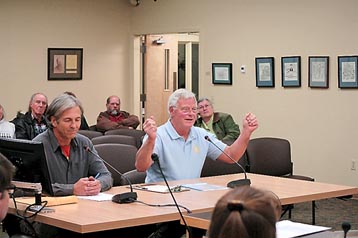That’s the way it seemed earlier in December when the planning commission considered a revised plat by developer Tony Neal for his 37-acre Quiet Creek Park subdivision above Homer High School — a subdivision it first looked at eight years ago in June 2005.
In public hearings, just as in 2005, and with many of the same people speaking again, testimony against the plat made the same points:
• By linking East End Road and East Hill Road to downtown neighborhoods to the west, Quiet Creek Park would increase traffic in areas that now have dead-end roads; and
• Quiet Creek Park could impact storm water drainage in the area and cause more flooding problems for downhill neighborhoods.
The planning commission held a public hearing on the Quiet Creek Park plat and started discussion at its Dec. 4 meeting, but ran out of time to vote. Discussion will be continued at its regular meeting starting 6:30 p.m. Jan. 2 in the Cowles Council Chambers, Homer City Hall. The public can comment during the plat portion at the beginning of the meeting or by sending written comments by email to planning@ci.homer.ak.us by 4 p.m. Jan. 2.
The Homer Advisory Planning Commission can only recommend approval of the preliminary plat. Final approval is by the Kenai Peninsula Borough Planning Commission. The borough planning commission in 2006 approved a 90-lot subdivision plat after the Homer Advisory Planning Commission recommended approval with conditions.
With other Homer subdivisions struggling to sell lots, Neal postponed development of Quiet Creek because of the recession, he said.
Neal has brought back a plat with fewer lots on larger parcels, more green space and a better drainage plan. The new plat in an area zoned rural-residential will include lots from 9,700-square-feet to 29,645-square-feet in size. Most lots would be a quarter-acre or half-acre.
“We think it’s a beautiful project,” Neal said in his presentation at the Dec. 4 meeting. “It’s a credit to Homer and we ask you to approve it.”
Along with the reduced number of lots, Neal and his surveyor, Kenton Bloom, said the new plat has these features:
• “Rain gardens,” or small ponds to collect drainage to minimize downhill impacts;
• Use of shared driveways to some lots; and
• Setting aside land for trails, green space buffers and parks in the subdivision.
In the Planning Department’s staff report, City Planner Rich Abboud recommended approval of the preliminary plat with conditions. Those conditions included increasing the size of one 9,700-square-foot lot to meet the 10,000-square-foot minimum and building Nelson Avenue and Ronda Street from East End Road to South Slope Drive. That connection would provide access to Quiet Creek Park from East Hill Road and East End Road.
The Quiet Creek Park plat would extend Nelson Avenue, an east-west street, to a new street, Anderson Street, and connect to Mountainview Drive and Elderberry Drive, two streets that now are dead-ends east of Kachemak Way. As in 2005, that connection still caused concern.
Tim Moore said he appreciated Abboud’s recommendation.
“That would allow for the construction to not impact the neighbors, probably the most common problem people have had with this flow of traffic,” he said.
Most people who spoke said they appreciated the changes in the new plat, but still had issues.
“I’m still concerned about the density in there,” said Tom Kizzia, who lives on Mountainview Drive. “The main concern with density for my neighbors and me is the traffic coming out some day into the neighborhoods west of the subdivision.”
John Fitzpatrick, who lives on Elderberry Drive, said during work on a water line recently, he could feel the impact of heavy trucks on his small street.
“My main concern is the traffic and the construction,” he said. “I’m really worried about the structure and integrity of the road.”
Another area resident, Ginny Espenshade, spoke of how severe flooding can be even with natural vegetation. In 2002 when Bear Creek flooded, streams dumped dirt on the high school football field. Espenshade, who spoke at the 2005 hearing, urged the commission to look at that record.
“Your body spent hours on this plat,” she said. “It got toxic, but a lot of good came out of that.”
Others talked about a change in the new plat, creating shared driveways. Some lots are connected with driveways instead of platted roads. That raised concerns about if fire equipment could access those driveways.
“What is a fire department shared accessible driveway?” asked Kathy George, referring to a condition recommended in the staff report.
In response to some of the testimony, Bloom, the surveyor, said the subdivision was boxed in by code in having to connect Nelson Avenue through to other neighborhoods. City codes limit the length of cul-de-sacs — streets that dead end. Fire Chief Bob Painter also recommended that the subdivision have two exits, which is why Abboud recommended building the East Hill-East End Road connection as part of the first phase of the project.
“We think traffic calming is really the answer,” Bloom said in response to traffic concerns.
Neal said rain gardens also should slow the flow of water through the area.
“When water flows down off the roof, it will be stopped before it floods,” he said. “Stop it before it gets wild and becomes a big flood.”
Michael Armstrong can be reached at michael.
armstrong@homernews.com.


